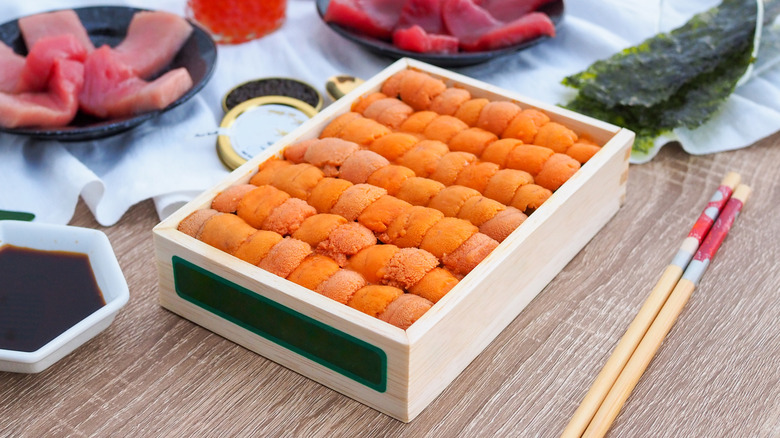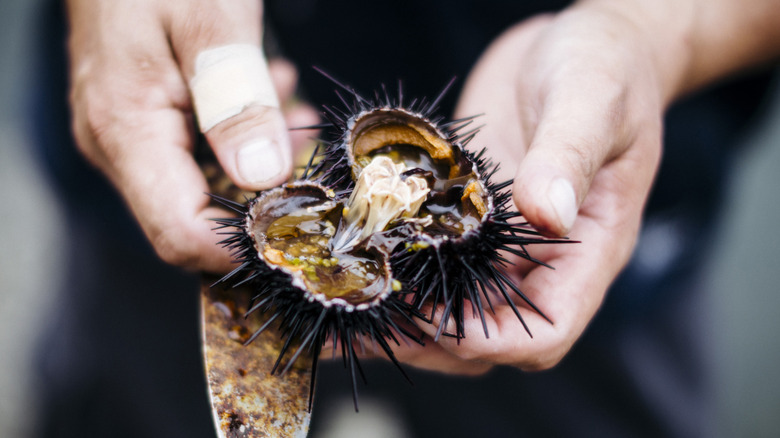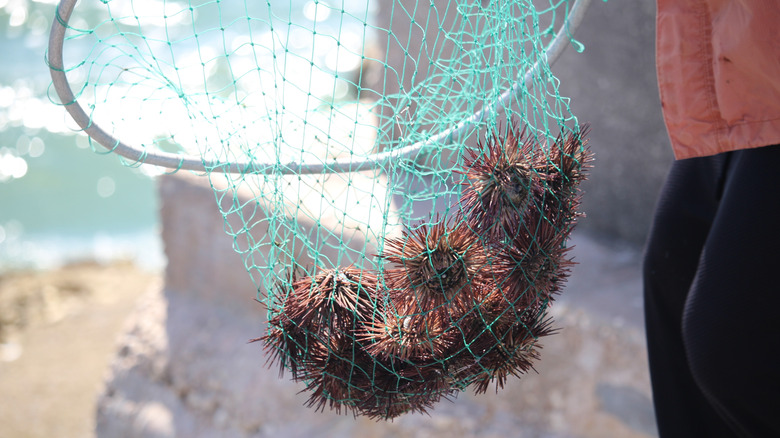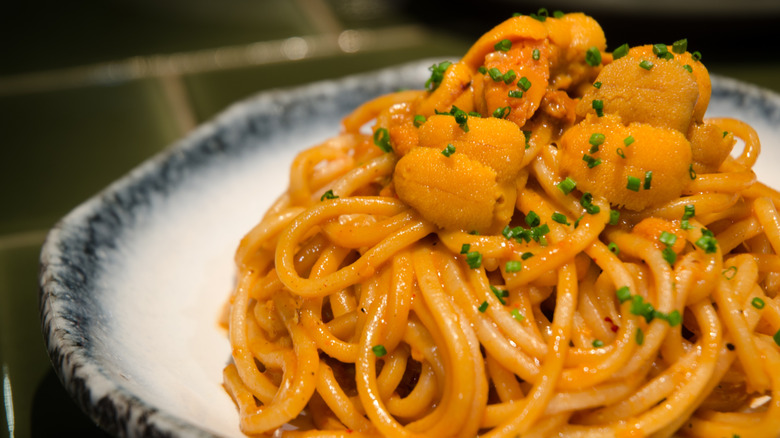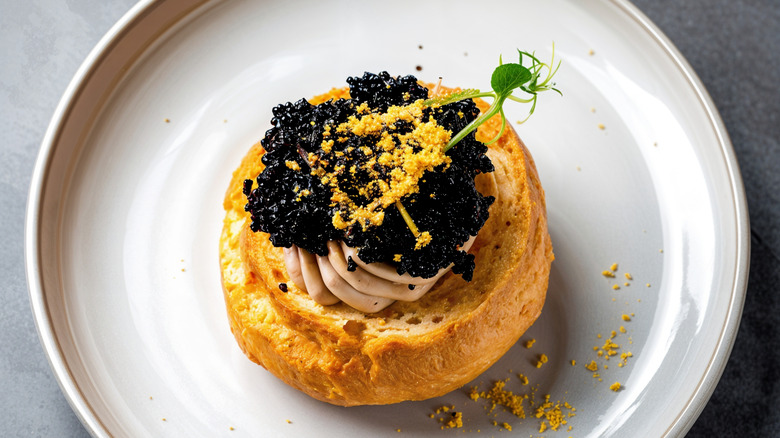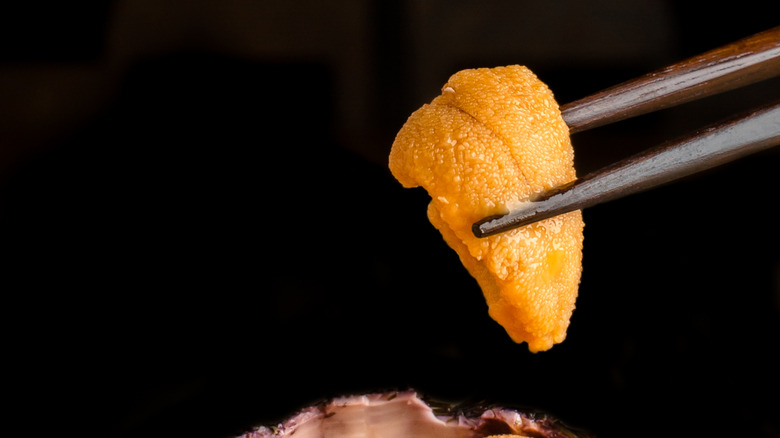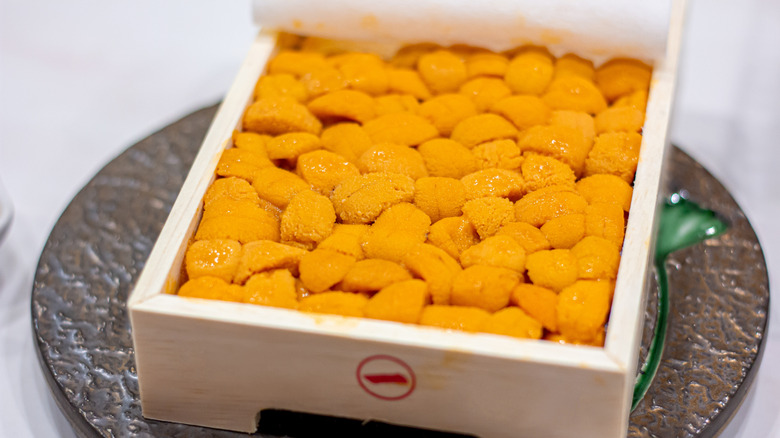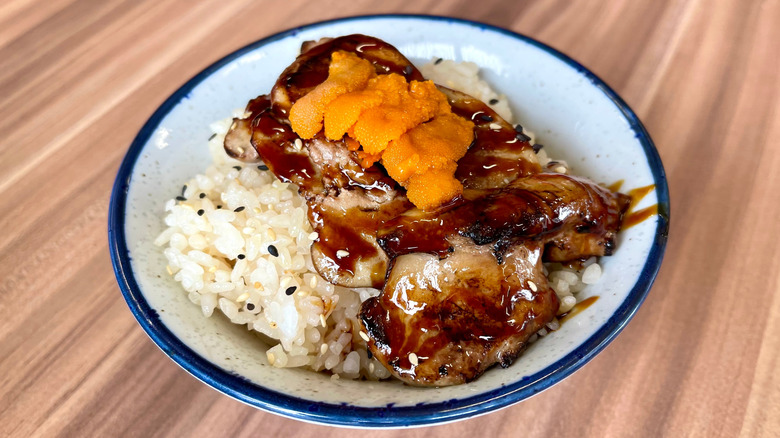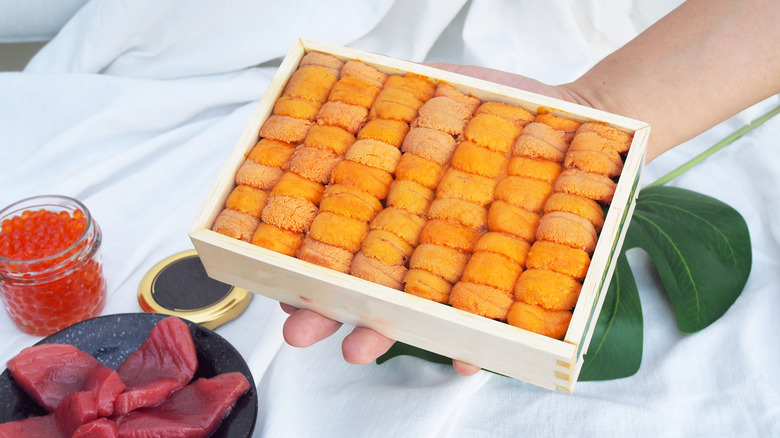How To Use Uni: A Beginners Guide
Uni (pronounced "oou-nee") is one of the most luxurious but polarizing ingredients in Japanese cuisine. It refers to the edible gonads of sea urchins, known for their bright golden hue and rich, custard-like texture. Long revered in Japan and now increasingly celebrated around the world, uni has become a delicacy featured in both traditional dishes and modern culinary experiments. As it is a delicacy, it is typically not a sushi menu staple but can be found at high-end restaurants or omakase, where they focus on seasonal ingredients. Some diners (like Gordon Ramsay) are captivated by its sweet and oceanic flavor, while others find its intense brininess and unfamiliar texture challenging.
This guide explores uni in-depth, covering its biological origins, harvesting regions, different grades, culinary uses, nutritional value, and proper storage. It also provides practical tips for selecting and preparing uni at home.
To enrich this guide, several experts have contributed their knowledge and firsthand experience. Namiko Hirasawa Chen, author of "Just One Cookbook," brings a home cook's perspective rooted in modern Japanese recipes. Jamel Jones, Head Chef at Jōtō Chicago, shares professional insights on the taste, storage, and sourcing of uni. Chef Patrick Pham, Head Chef at Bar Doko, offers a view of uni in contemporary cuisine. Registered dietitian Rima Kleiner, the voice of the non-profit fishery organization Dish on Fish, provides an analysis of the nutritional and health considerations of uni. Together, these voices help illuminate what makes uni both revered and complex around the world.
What is uni?
Sea urchins are marine invertebrates covered in spiny shells. They crawl along the bottom of the ocean and scrape off plant material from the sea floor for nutrition. Though often mistaken as roe, uni is not the urchin's eggs but its reproductive organs. There are typically five lobes of uni in each urchin, arranged in a star-like formation along the interior of the shell. These lobes are harvested delicately to preserve their structure and are prized for their vivid color, firm yet creamy texture, and briny-sweet flavor.
Sea urchins are part of the echinoderm family, which also includes sand dollars and sea cucumbers. Over 950 species of sea urchins exist globally, but only a small number are harvested commercially for consumption.
In culinary contexts, the word "uni" is almost always associated with Japanese cuisine, where it is served atop sushi rice, folded into tamago, or enjoyed simply with a dab of wasabi and soy sauce. However, uni also appears in Italian pasta, Korean bibimbap, and high-end fusion dishes around the world. The best uni retains its shape and glistens with natural moisture, offering a textural and flavor experience that is both rich and delicate.
Where does uni come from?
Uni is harvested from sea urchins that inhabit rocky coastal waters across the globe. These creatures thrive in temperate and cold-water environments and are most commonly found clinging to rocks, reefs, and kelp beds where they graze on algae. The clean, cold currents of the Pacific Ocean produce some of the highest quality uni in the world. Notable sources include the coasts of Japan, USA, Chile, Korea (caught by haenyeo — female free-divers specifically trained to catch wild seafood), and Canada.
Japan remains the most iconic producer, particularly Hokkaido. There, divers hand-pick sea urchins from the seafloor, contributing to sustainable fishing practices and premium-grade products. These cold waters yield sweet, firm uni with consistent flavor and structure. Maine is also a popular region with sea urchin hatcheries that help sustainably repopulate the species.
On the west coast of North America, both California and British Columbia are important uni-producing regions. British Columbia, in particular, offers cold, clear waters and expansive kelp forests along the coastlines of Vancouver Island and the Gulf Islands. Local divers often work within government-regulated quotas to preserve the marine ecosystem and ensure long-term viability.
The location, species, and harvesting method all influence the quality of uni. Cold, clean waters produce sweeter, firmer lobes with bright color and excellent structure. Warmer regions may produce uni that are looser in texture and more metallic in taste. These environmental differences contribute significantly to both flavor profile and market value.
What does uni taste like?
Uni has a distinctive flavor that is difficult to compare to other ingredients. When fresh and high in quality, uni delivers a rich, buttery mouthfeel with layers of ocean salinity, natural sweetness, and umami depth. The flavor often begins with a slightly briny note that gives way to a sweet, custard-like finish. Its texture is soft and creamy, yet it holds its shape when properly handled. Similar to how you should avoid using too many condiments on sushi, uni is also best tasted on its own.
Jamel Jones, Head Chef at Jōtō Chicago, describes uni as "sea butter" for its luxurious richness and gradual flavor evolution. The texture can be slightly firm at first, but it quickly melts into a creamy, almost whipped consistency. This duality of texture and taste is what makes uni so sought-after in fine dining. He notes that good uni should have structure and creaminess without being watery or metallic. The flavor gently transitions from saline to sweet, making it a prized delicacy in sushi and sashimi.
Uni's flavor varies significantly depending on its source. Hokkaido uni is known for its clean, sweet profile, while California and British Columbia varieties often carry a bolder, more robust flavor. Environmental conditions such as the urchin's diet, water temperature, and freshness after harvest can all impact the taste.
How to cook with uni
Uni is most often served raw, particularly in sushi and sashimi (yes, there is a difference), where its creamy texture and oceanic flavor are left untouched. However, cooking with uni can bring out an entirely different dimension. Its natural creaminess makes it an ideal emulsifier in rich sauces and butter, while its umami depth adds luxury to even the simplest preparations.
Rima Kleiner, MS, RDN and voice of the non-profit fishery blog, Dish on Fish, highlights uni's ability to elevate warm dishes. It can be blended into scrambled eggs for a subtle oceanic note, folded into mashed potatoes, or stirred into hot rice for a delicate burst of umami. When used in butter or whisked into olive oil, uni can become a decadent spread for grilled seafood or crusty bread.
In pasta dishes, uni melts beautifully into warm cream or butter, forming a velvety sauce that coats noodles in briny richness. This technique, inspired by Italian-Japanese fusion cuisine, is popular in restaurants and accessible for home cooks. Gently warming the uni, without high heat, helps preserve its flavor while integrating it into the dish. It is also an unexpectedly good surf and turf pairing with steak.
While raw uni highlights purity, cooked applications offer versatility. Its ability to enrich a sauce or elevate a composed dish makes uni a powerful ingredient when used with intention. Gentle handling, minimal heat, and complementary ingredients are key to maintaining its delicate structure and taste.
Types of uni
Uni varies widely in flavor, color, texture, and price depending on the species, place of origin, and whether it is wild or farmed. According to Chef Patrick Pham of Bar Doko, in the North American market, the three most commonly encountered types are red, green, and purple sea urchins, each with their own characteristics and flavor profiles.
The red sea urchin, also known as Aka uni, is typically harvested in Japan. It has a bold and briny flavor that stands up well in sushi preparations. The green sea urchin, or Bafun uni (translated to "horse poop uni"), is found in both Japan and the northeastern United States, particularly Maine. It is generally harvested from deep waters, giving it a more pronounced and slightly sweeter taste. The purple sea urchin, called Murasaki uni, is common along the coasts of Japan and California. It is lighter in color (mustard yellow) and often milder and creamier in flavor, making it a popular choice for those who are new to eating uni.
Chef Pham elaborates that the diet of the sea urchin plays a major role in its final taste. Urchins that feed on high-quality kelp in clean, cold waters tend to produce sweeter and firmer uni. Location, water quality, and species all contribute to the texture and flavor outcome.
Uni is also graded based on quality, particularly in Japanese markets. Grade A uni is the most prized, featuring vibrant, golden color, intact structure, and clean flavor.
Where (and how) to buy uni
Buying uni requires attention to detail, especially when quality can vary so dramatically between sources. The best place to purchase uni is through a trusted fishmonger or seafood supplier with experience in handling high-end, perishable seafood. Specialty Japanese markets, local fish mongers and online seafood retailers often carry fresh uni imported directly from Japan or sourced locally from California, British Columbia, or Maine. Purchasing from a vendor that sells to sushi restaurants can improve the chances of getting premium-grade uni.
Quality is judged primarily on three criteria: color, shape, and texture. Ideal uni displays a vibrant golden to deep orange hue, uniform lobe shape without excessive shrinkage or fraying, and a custard-like texture that is soft but still holds its form. These visual and tactile markers are crucial for determining freshness and suitability for raw consumption.
In Japan, uni is graded into three main categories: Gokujo/Jo ("perfect quality"), Nami ("conforming to quality"), and Yasu ("average"). Jo uni has a rich golden color, firm structure, and clean, sweet flavor with a glossy surface and no blemishes. This is the grade most often used for high-end sushi. Nami may still have a desirable flavor and color but may lack perfect shape or firmness. Yasu is ranked 2 out of 5 stars on color, shape, and texture.
Rima Kleiner recommends avoiding uni with a strong ammonia-like smell, brown or gray coloration, and watery or overly firm texture. These signs indicate age or improper storage. For the highest quality experience, purchase fresh uni in small quantities and consume it the same day or within 24 hours. If you are new to uni, starting with a small amount from a reputable Japanese market is often the best way to experience its true flavor and texture.
Nutritional information about uni
Uni is not only prized for its flavor but also valued for its nutritional composition. It is a naturally low-calorie, protein-rich seafood that delivers essential nutrients in each bite. A 1-ounce (28-gram) serving of fresh uni contains approximately 35 to 45 calories, about 3 grams of protein, and minimal fat. Despite its creamy mouthfeel, uni is relatively low in saturated fat and cholesterol.
Uni is a good source of antioxidants and omega-3 fatty acids, which contribute to cardiovascular health, reduce inflammation, and support brain function. These fatty acids also play a role in maintaining healthy skin and improving mood regulation. The unique balance of lipids in uni is part of what gives it that signature soft, rich texture.
In addition to healthy fats, uni provides several key micronutrients. It contains vitamin A, which is important for vision and immune health. It also contains zinc, iron, and potassium in smaller amounts.
Rima Kleiner, MS, RDN, notes that uni's nutritional value can vary slightly depending on species, diet, and region. She emphasizes that uni is nutrient-dense and can be part of a balanced diet when enjoyed in moderation. While rich in flavor, its relatively light nutritional profile makes it a popular option for those seeking indulgent yet health-conscious seafood. As with any delicacy, freshness plays a critical role not only in taste but also in preserving the integrity of its nutrients.
How to store uni
Similar to storing and preparing sushi, proper storage is essential to preserving uni's delicate flavor and texture. As a highly perishable ingredient, uni requires immediate refrigeration and careful handling from the moment it is harvested. Most fresh uni is sold chilled, either in wooden trays or plastic containers, and should be kept cold but not frozen unless explicitly labeled for freezing.
Rima Kleiner recommends storing uni at a temperature between 34 to 38 degrees Fahrenheit, just above freezing. The container should be airtight to prevent exposure to air, which can quickly degrade both texture and taste. If the uni comes packed in a saltwater solution or with ice packs, leave it undisturbed in its original packaging until ready to serve. Excess liquid in the packaging may be a sign of deterioration, so any visible pooling should be a cue to use the uni immediately or discard it if the smell is off. Namiko Hirasawa Chen chimes in that once opened, uni should be consumed within 1 to 2 days.
Jamel Jones, Head Chef at Jōtō Chicago, adds that refrigeration alone is not enough. He recommends storing uni with ice packs placed above the container to maintain cool, consistent temperatures without allowing direct contact that might damage the lobes. The uni should always be kept level to avoid flattening or losing shape.
Plant-based substitutes for uni
For those following a plant-based diet or looking to replicate the luxurious texture and oceanic flavor of uni without seafood, several creative alternatives have emerged in both home kitchens and professional restaurants. While no plant-based substitute can fully capture the complexity of fresh uni, some ingredients and techniques come close in terms of flavor, color, and mouthfeel.
One common approach involves blending roasted or steamed carrots with white miso, soy sauce, and a touch of nori or kelp powder. This combination produces a sweet, umami-rich purée with a briny edge and silky texture. When piped into sushi or served on crostini, this mixture mimics the custardy consistency and savory-sweet notes of uni, making it a compelling option for vegan diners.
Another method uses marinated eggplant or tofu. Silken tofu, when blended with nutritional yeast, dashi powder (vegan versions available), and seaweed, yields a creamy base that can be spooned over rice or pasta. The addition of turmeric or annatto oil helps approximate uni's golden-orange hue. Eggplant, especially when roasted and lightly smoked, also offers a melt-in-the-mouth quality that resembles uni's soft texture.
Chefs experimenting with molecular gastronomy sometimes use agar or carrageenan to create uni-like gels using plant-based stocks infused with seaweed, mushrooms, or miso. These gels can be molded into shapes that mimic uni lobes and served in gunkan-style sushi.
While none of these substitutes fully replicate the nuanced flavor of high-quality uni, they succeed in offering a similar indulgent experience. For plant-based eaters, they provide a thoughtful and delicious way to enjoy the essence of the sea without compromising dietary principles.
